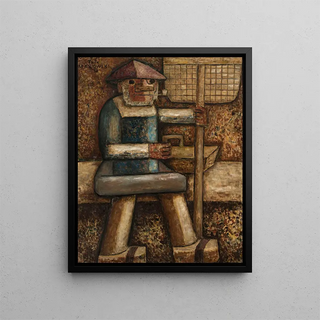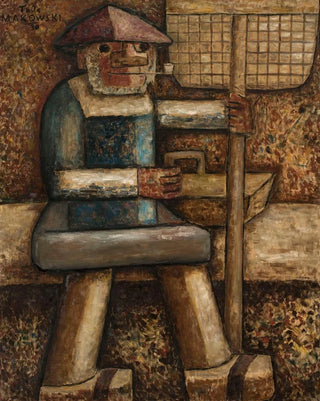Art print | Fisherman - Tadeusz Makowski


View from behind

Frame (optional)
In the vibrant world of modern art, the artwork "Pêcheur" by Tadeusz Makowski stands out for its visual poetry and delicate atmosphere. This piece, which subtly evokes the simplicity of rural life, invites the viewer to immerse themselves in a world where time seems to stand still. The scene depicted by the artist reveals a snapshot of a fisherman's life, a man in harmony with the nature around him. The soft colors and stylized forms create a composition that is both soothing and evocative, allowing everyone to see themselves in it. The art print of this work is not just a decorative addition; it is a true invitation to contemplation and reflection on our relationship with nature and our environment.
Style and uniqueness of the work
Tadeusz Makowski's style is characterized by a unique approach that blends cubist influences and elements of folk art. In "Pêcheur," this fusion is expressed through geometric shapes and pastel colors that lend a lightness to the scene. The artist manages to capture the essence of his subject with disarming simplicity, while playing with shadows and lights to bring his character to life. The stylized features of the fisherman, as well as the landscape elements, demonstrate undeniable technical mastery. This artwork is a celebration of everyday life, a tribute to those who live in harmony with their environment, and it invites reflection on the beauty of simple gestures. The way Makowski uses color and form to evoke emotions and atmospheres makes "Pêcheur" a work of great depth.
The artist and his influence
Tadeusz Makowski, Polish artist of the early 20th century, left his mark on his era with his distinctive style and bold aesthetic choices. Operating within a lively artistic context, he drew inspiration from contemporary currents while remaining true to his personal vision. Makowski had a rich journey, between Poland and France, where he interacted with many influential artists. His ability to translate human emotions through scenes of everyday life

Matte finish

View from behind

Frame (optional)
In the vibrant world of modern art, the artwork "Pêcheur" by Tadeusz Makowski stands out for its visual poetry and delicate atmosphere. This piece, which subtly evokes the simplicity of rural life, invites the viewer to immerse themselves in a world where time seems to stand still. The scene depicted by the artist reveals a snapshot of a fisherman's life, a man in harmony with the nature around him. The soft colors and stylized forms create a composition that is both soothing and evocative, allowing everyone to see themselves in it. The art print of this work is not just a decorative addition; it is a true invitation to contemplation and reflection on our relationship with nature and our environment.
Style and uniqueness of the work
Tadeusz Makowski's style is characterized by a unique approach that blends cubist influences and elements of folk art. In "Pêcheur," this fusion is expressed through geometric shapes and pastel colors that lend a lightness to the scene. The artist manages to capture the essence of his subject with disarming simplicity, while playing with shadows and lights to bring his character to life. The stylized features of the fisherman, as well as the landscape elements, demonstrate undeniable technical mastery. This artwork is a celebration of everyday life, a tribute to those who live in harmony with their environment, and it invites reflection on the beauty of simple gestures. The way Makowski uses color and form to evoke emotions and atmospheres makes "Pêcheur" a work of great depth.
The artist and his influence
Tadeusz Makowski, Polish artist of the early 20th century, left his mark on his era with his distinctive style and bold aesthetic choices. Operating within a lively artistic context, he drew inspiration from contemporary currents while remaining true to his personal vision. Makowski had a rich journey, between Poland and France, where he interacted with many influential artists. His ability to translate human emotions through scenes of everyday life






